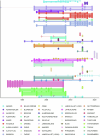Plant diversity dynamics over space and time in a warming Arctic
- PMID: 40307554
- PMCID: PMC12176628
- DOI: 10.1038/s41586-025-08946-8
Plant diversity dynamics over space and time in a warming Arctic
Abstract
The Arctic is warming four times faster than the global average1 and plant communities are responding through shifts in species abundance, composition and distribution2-4. However, the direction and magnitude of local changes in plant diversity in the Arctic have not been quantified. Using a compilation of 42,234 records of 490 vascular plant species from 2,174 plots across the Arctic, here we quantified temporal changes in species richness and composition through repeat surveys between 1981 and 2022. We also identified the geographical, climatic and biotic drivers behind these changes. We found greater species richness at lower latitudes and warmer sites, but no indication that, on average, species richness had changed directionally over time. However, species turnover was widespread, with 59% of plots gaining and/or losing species. Proportions of species gains and losses were greater where temperatures had increased the most. Shrub expansion, particularly of erect shrubs, was associated with greater species losses and decreasing species richness. Despite changes in plant composition, Arctic plant communities did not become more similar to each other, suggesting no biotic homogenization so far. Overall, Arctic plant communities changed in richness and composition in different directions, with temperature and plant-plant interactions emerging as the main drivers of change. Our findings demonstrate how climate and biotic drivers can act in concert to alter plant composition, which could precede future biodiversity changes that are likely to affect ecosystem function, wildlife habitats and the livelihoods of Arctic peoples5,6.
© 2025. Crown.
Conflict of interest statement
Competing interests: The authors declare no competing interests.
Figures














Similar articles
-
Signs and symptoms to determine if a patient presenting in primary care or hospital outpatient settings has COVID-19.Cochrane Database Syst Rev. 2022 May 20;5(5):CD013665. doi: 10.1002/14651858.CD013665.pub3. Cochrane Database Syst Rev. 2022. PMID: 35593186 Free PMC article.
-
The stability of plant richness, composition, and cover responds nonlinearly to warming in a decade-long experiment.Ecology. 2025 Jul;106(7):e70142. doi: 10.1002/ecy.70142. Ecology. 2025. PMID: 40620163
-
Sertindole for schizophrenia.Cochrane Database Syst Rev. 2005 Jul 20;2005(3):CD001715. doi: 10.1002/14651858.CD001715.pub2. Cochrane Database Syst Rev. 2005. PMID: 16034864 Free PMC article.
-
Underlying mechanisms of spatial distribution of prokaryotic community in surface seawater from Arctic Ocean to the Sea of Japan.Microbiol Spectr. 2025 Jul;13(7):e0051725. doi: 10.1128/spectrum.00517-25. Epub 2025 May 30. Microbiol Spectr. 2025. PMID: 40444437 Free PMC article.
-
Distribution Range and Richness of Plant Species Are Predicted to Increase by 2100 due to a Warmer and Wetter Climate in Northern China.Glob Chang Biol. 2025 Jul;31(7):e70334. doi: 10.1111/gcb.70334. Glob Chang Biol. 2025. PMID: 40613311 Free PMC article.
References
-
- IPCC. Climate Change 2021: The Physical Science Basis. Contribution of Working Group I to the Sixth Assessment Report of the Intergovernmental Panel on Climate Change (eds Masson-Delmotte, V. et al.) (Cambridge Univ. Press, 2021).
-
- Elmendorf, S. C. et al. Plot-scale evidence of tundra vegetation change and links to recent summer warming. Nat. Clim. Change2, 453–457 (2012).
-
- Myers‐Smith, I. H. & Hik, D. S. Climate warming as a driver of tundra shrubline advance. J. Ecol.106, 547–560 (2018).
-
- García Criado, M., Myers‐Smith, I. H., Bjorkman, A. D., Lehmann, C. E. R. & Stevens, N. Woody plant encroachment intensifies under climate change across tundra and savanna biomes. Glob. Ecol. Biogeogr.29, 925–943 (2020).
-
- Wookey, P. A. et al. Ecosystem feedbacks and cascade processes: understanding their role in the responses of Arctic and alpine ecosystems to environmental change. Glob. Chang. Biol.15, 1153–1172 (2009).
MeSH terms
LinkOut - more resources
Full Text Sources

